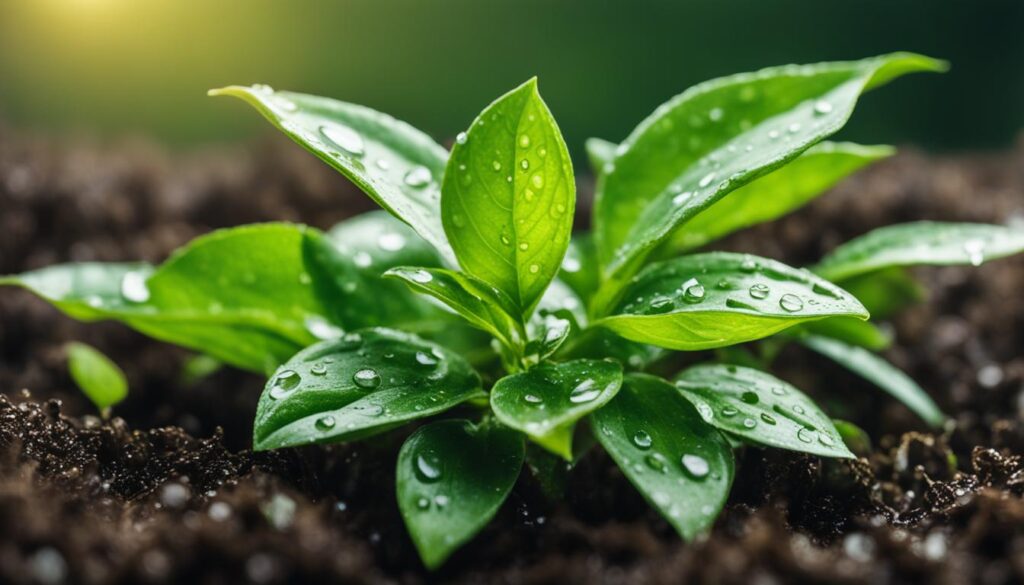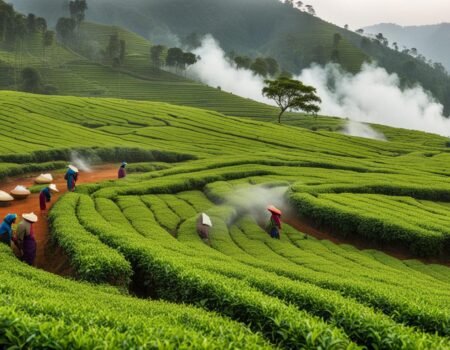
Watering Schedules for Tea Cultivation: Best Practices
Welcome to our guide on watering schedules for tea cultivation! As tea enthusiasts and experts, we understand the importance of proper watering techniques to ensure healthy and thriving tea plants. In this article, we will explore the best practices for watering tea plants, the hydration requirements of tea plants, water conservation techniques for tea gardens, tea cultivation in dry climates, and monitoring soil moisture in tea cultivation. So, let’s dive in and discover how to keep your tea plants hydrated and vibrant throughout their growth journey!
Key Takeaways:
- Following a proper watering schedule is crucial for optimal tea cultivation results.
- Tea plants require regular and consistent watering for healthy growth.
- Water conservation techniques like drip irrigation and mulching can minimize water usage in tea gardens.
- Choosing drought-tolerant cultivars and monitoring soil moisture levels are essential in dry climates.
- Monitoring soil moisture helps prevent water stress and ensures plant health and productivity.
Tea Plant Hydration Requirements
Proper hydration is essential for the growth and development of tea plants. Tea plants require regular and consistent watering to thrive and produce high-quality leaves. To ensure optimal hydration, it is important to consider the soil conditions and watering practices.
Soil Conditions
Tea plants thrive in well-drained soils with a pH range of 5.0 to 5.8. It is crucial to ensure that the soil is not overly compacted or waterlogged, as this can impede root growth and lead to root rot. Regularly monitoring soil moisture levels using soil moisture sensors can help determine the watering needs of tea plants and prevent over or under-watering.
Watering Practices
Tea plants should be watered consistently, especially during periods of dry weather. For tea plants in containers, it is recommended to water them when the top inch or two of soil feels dry. In-ground tea plants should receive at least one inch of water per week, either through rainfall or irrigation. Deep watering is crucial to encourage strong root development and ensure water reaches the root zone.
Mulching for Moisture Retention
Mulching around tea plants can help retain soil moisture and reduce water evaporation. Organic mulch, such as wood chips or straw, can be applied around the base of the plants to create a protective layer. This layer helps regulate soil temperature, suppresses weed growth, and conserves water by reducing evaporation. Regularly replenishing the mulch layer ensures its effectiveness.

| Tea Plant Hydration Tips | Benefits |
|---|---|
| Monitor soil moisture levels regularly | Prevents over or under-watering |
| Water tea plants in containers when top inch or two of soil feels dry | Ensures proper hydration without waterlogging |
| Water in-ground tea plants with at least one inch of water per week | Provides sufficient moisture for healthy growth |
| Deep watering to encourage strong root development | Ensures water reaches the root zone |
| Mulch around tea plants to retain soil moisture | Reduces water evaporation and suppresses weed growth |
Water Conservation Techniques for Tea Gardens
As tea growers, we understand the importance of conserving water in our gardens to promote sustainability and ensure the long-term health of our tea plants. Implementing effective water conservation techniques not only helps us reduce water usage but also contributes to the overall productivity and quality of our tea crops. In this section, we will explore some key strategies and practices that can help us conserve water in our tea gardens.
1. Drip Irrigation Systems
Drip irrigation is a highly efficient method of delivering water directly to the root zone of our tea plants, minimizing water wastage and maximizing water absorption. By installing drip irrigation systems in our gardens, we can significantly reduce water usage and ensure that the water reaches the plants where it is needed the most. This method also helps prevent water runoff and evaporation, further conserving our precious water resources.
2. Rainwater Harvesting
Rainwater harvesting is another effective technique to conserve water in our tea gardens. By collecting and storing rainwater, we can use it for irrigation purposes during dry periods, reducing our reliance on external water sources. Implementing rainwater harvesting systems not only helps us save water but also contributes to the sustainability of our tea cultivation practices.
3. Efficient Garden Design
The design of our tea gardens plays a crucial role in optimizing water usage. By implementing efficient garden designs with proper spacing and layout, we can minimize water runoff and ensure that the water is distributed evenly across the garden. Additionally, planting shade trees or using mulch can help retain soil moisture and reduce water evaporation, further conserving water in our tea gardens.
By implementing these water conservation techniques, we can contribute to the sustainable cultivation of tea and ensure the long-term viability of our tea gardens. Conserving water not only benefits the environment but also helps us achieve better quality tea crops and more efficient resource management.
Tea Cultivation in Dry Climates
Cultivating tea in dry climates poses unique challenges that require effective water management techniques. With limited rainfall and high evaporation rates, tea plants in these regions can easily succumb to dehydration and stress. To ensure the health and survival of tea plants, growers must implement strategies that conserve water and provide adequate hydration.
One key approach is to choose drought-tolerant tea cultivars that are naturally more resilient to dry conditions. These cultivars have adapted to survive with less water and can thrive in arid environments. By selecting the right cultivars, growers can minimize water requirements without compromising the quality of the tea produced.
| Tea Cultivar | Water Requirements |
|---|---|
| Camellia sinensis ‘Drought King’ | Low |
| Camellia sinensis ‘Desert Dew’ | Moderate |
| Camellia sinensis ‘Dryland Sunrise’ | Low |
Another crucial aspect of tea cultivation in dry climates is the implementation of efficient irrigation systems, such as drip irrigation. Unlike traditional overhead sprinklers that can result in significant water loss due to evaporation, drip irrigation delivers water directly to the plant roots, reducing wastage and improving water efficiency.
“Drip irrigation is a game-changer for tea cultivation in dry climates. It allows us to provide targeted watering to our tea plants, ensuring they receive the necessary moisture without wasting water through evaporation.” – Tea grower
In addition to efficient irrigation, mulching is an effective technique for conserving moisture in the soil. Applying a layer of organic mulch around the base of tea plants helps to retain soil moisture, reducing water evaporation and keeping the root zone cool. Organic mulches such as straw, wood chips, or compost can also provide additional nutrients to the soil as they break down over time.

Tea cultivation in dry climates requires a proactive and well-planned approach to water management. By choosing drought-tolerant cultivars, implementing efficient irrigation systems, and employing mulching techniques, tea growers can successfully navigate the challenges of cultivating tea in arid environments, ensuring the long-term viability and productivity of their tea gardens.
Monitoring Soil Moisture in Tea Cultivation
Ensuring proper soil moisture levels is crucial for the successful cultivation of tea plants. By monitoring soil moisture, tea growers can make informed decisions regarding irrigation and prevent issues like water stress and root rot. Using soil moisture sensors or meters provides accurate and real-time data on soil moisture content, allowing tea growers to determine the optimal time for irrigation.
By maintaining optimal soil moisture levels, tea plants can efficiently take up water and nutrients, promoting healthy growth and productivity. It is important to note that soil moisture requirements may vary depending on factors such as climate, soil type, and specific tea cultivars. Regular monitoring ensures that tea growers can adjust their watering practices accordingly, preventing both overwatering and underwatering.
In addition to soil moisture sensors, tea growers can also use visual cues to assess soil moisture levels. For example, dry and cracked soil is an indication of insufficient moisture, while waterlogged soil suggests excessive watering. Tea plants should ideally be grown in soil that is moist but not saturated, ensuring optimal root health and nutrient uptake. Implementing proper irrigation techniques and closely monitoring soil moisture levels are key to maintaining a healthy tea garden.
Benefits of Monitoring Soil Moisture
- Prevents water stress and dehydration in tea plants.
- Ensures optimal nutrient uptake for healthy growth.
- Prevents issues like root rot and other water-related diseases.
- Helps tea growers adjust watering practices based on real-time data.
- Optimizes water usage, promoting sustainability in tea cultivation.
By actively monitoring soil moisture levels, tea growers can make informed decisions regarding irrigation, leading to healthier plants, higher yields, and improved tea quality. Implementing soil moisture monitoring techniques is an essential component of successful tea cultivation.
| Soil Moisture Level | Significance |
|---|---|
| Moist but not saturated | Ideal soil moisture level for tea plants, promotes healthy growth and nutrient uptake. |
| Dry and cracked soil | Indicates insufficient moisture, tea plants may require watering. |
| Waterlogged soil | Indicates excessive watering, tea plants may be at risk of root rot and other water-related diseases. |
Conclusion
In conclusion, effective water management is key for successful tea cultivation. By following a proper watering schedule and providing regular hydration, tea plants can thrive and produce high-quality leaves. It is important to choose the right fertilizers and avoid over-fertilization to prevent leaf damage and nutrient imbalances.
Implementing water-efficient tea garden designs, such as proper spacing and layout, can optimize water usage and minimize wastage. Mulching and rainwater harvesting systems help conserve water and maintain soil moisture levels. Monitoring soil moisture using sensors ensures that tea plants receive adequate water without being over or under-watered.
For tea growers looking to streamline their water management practices, using water management software can be highly beneficial. This software enables efficient scheduling of irrigation based on specific plant needs, reducing water waste and maximizing water resources.
By implementing these best practices, including water-efficient garden designs and utilizing water management software, tea growers can promote sustainability, conserve water, and enhance their tea cultivation experience. With proper water management, tea gardens can flourish and continue to produce flavorful and aromatic tea for years to come.
FAQ
What is the proper watering schedule for tea cultivation?
Tea plants should be watered regularly, especially during dry weather. Container-grown tea plants should be watered when the top inch or two of soil feels dry. Tea plants in the ground should receive at least one inch of water per week, either through rainfall or irrigation.
When should I fertilize tea plants?
Tea plants should be fertilized in early spring, with monthly applications until early summer. The ideal fertilizer for tea plants should have a balanced mix of nutrients, with slightly higher levels of phosphorus.
Can I over-fertilize my tea plants?
Yes, over-fertilizing can lead to issues like brown leaf tips, wilting leaves, and fertilizer burn. It is important to follow the recommended dosage and not exceed it.
Can I fertilize tea plants during hot and dry periods?
It is not ideal to fertilize tea plants during hot and dry periods, as the dry soil does not effectively deliver nutrients. Wait until the weather cools down and there is sufficient moisture in the soil.
How much water do tea plants need?
Tea plants in the ground should receive at least one inch of water per week. Container-grown tea plants should be watered when the top inch or two of soil feels dry. Deep watering is important to encourage strong root development and ensure water reaches the root zone.
How can I conserve water in my tea garden?
Implementing water-efficient techniques such as drip irrigation and rainwater harvesting can significantly reduce water usage. Efficient tea garden designs and proper spacing can also optimize water usage and minimize runoff.
What should I do if I’m cultivating tea in a dry climate?
Mulching is essential to retain soil moisture. Choosing drought-tolerant tea cultivars and implementing efficient irrigation systems like drip irrigation can also help conserve water in dry climates. Supplemental watering during dry spells is crucial, but be careful not to overwater.
Why is monitoring soil moisture important in tea cultivation?
Monitoring soil moisture levels helps tea growers determine the optimal time for irrigation and prevent both over and under-watering. It also helps prevent issues like waterlogging, which can lead to root rot and other diseases.
How can water management software assist in tea cultivation?
Water management software can help tea growers efficiently manage water resources and schedule irrigation based on plant needs. It provides real-time data on soil moisture levels, enabling growers to make informed decisions to conserve water and ensure the health and productivity of tea plants.






